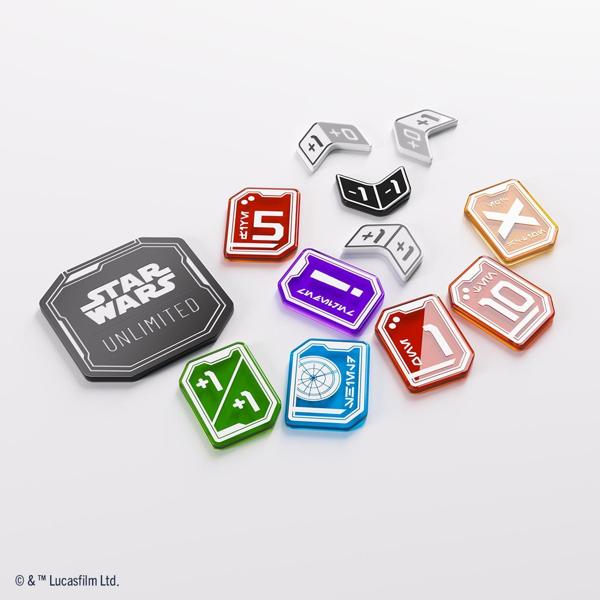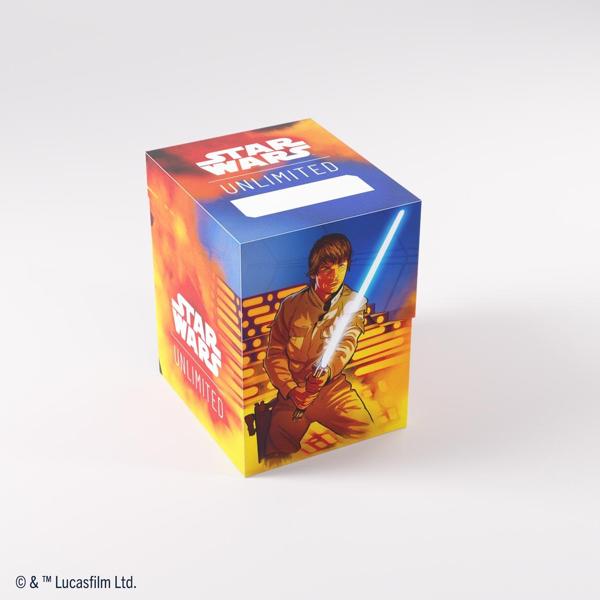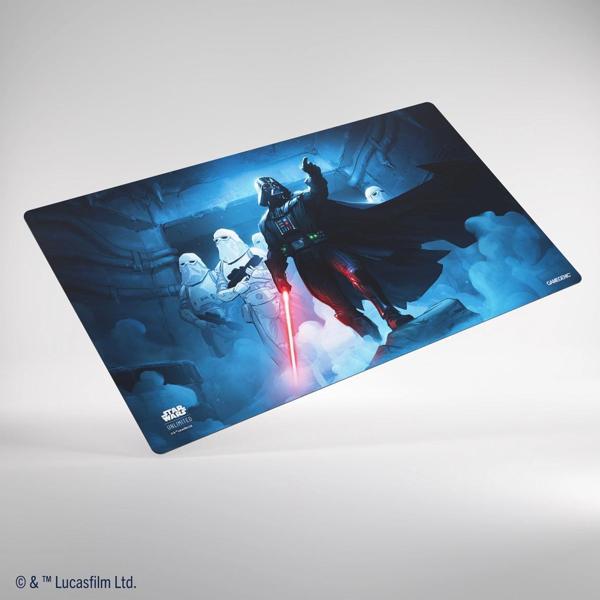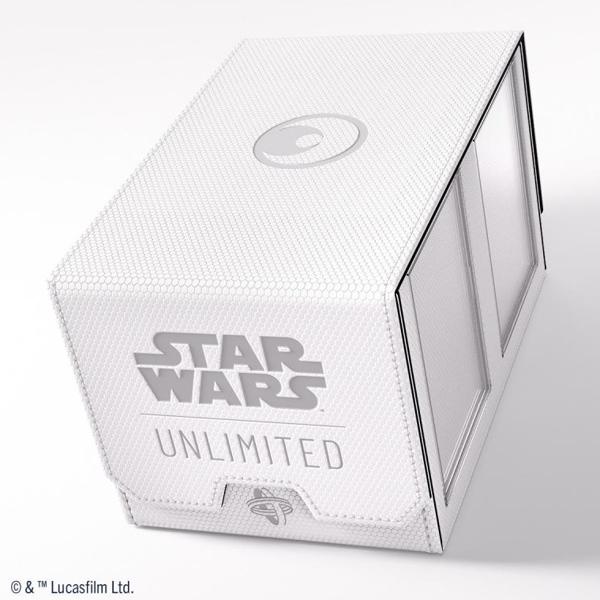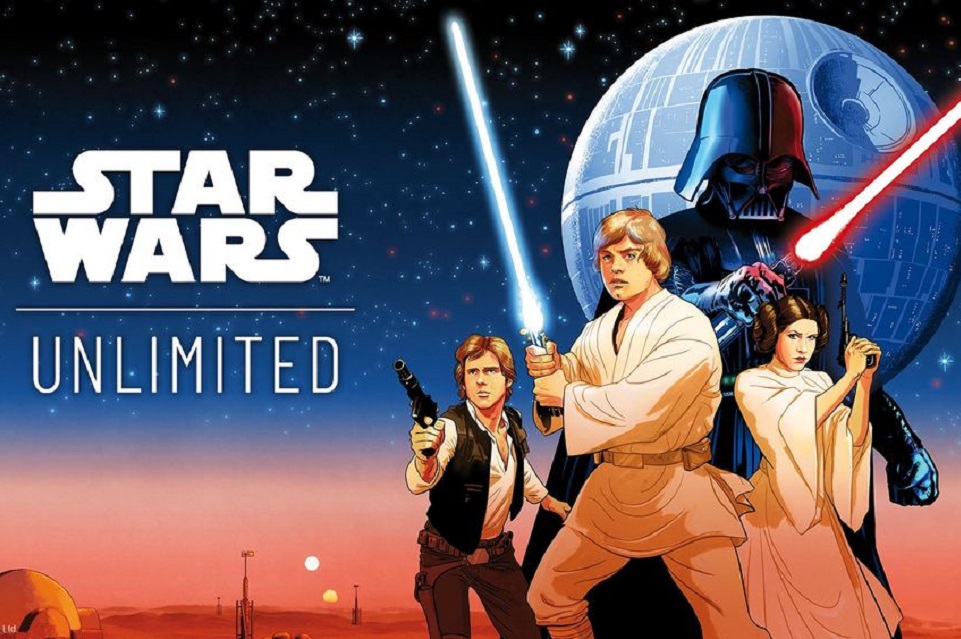
In May we have Star Wars™: Unlimited was officially announced as the latest and greatest trading card game from Fantasy Flight Games. Now we are looking forward to presenting one of the first products for the game and giving you a detailed insight into the gameplay!
Introduction: The spark of a rebellion 2-player starter
Two-player starter
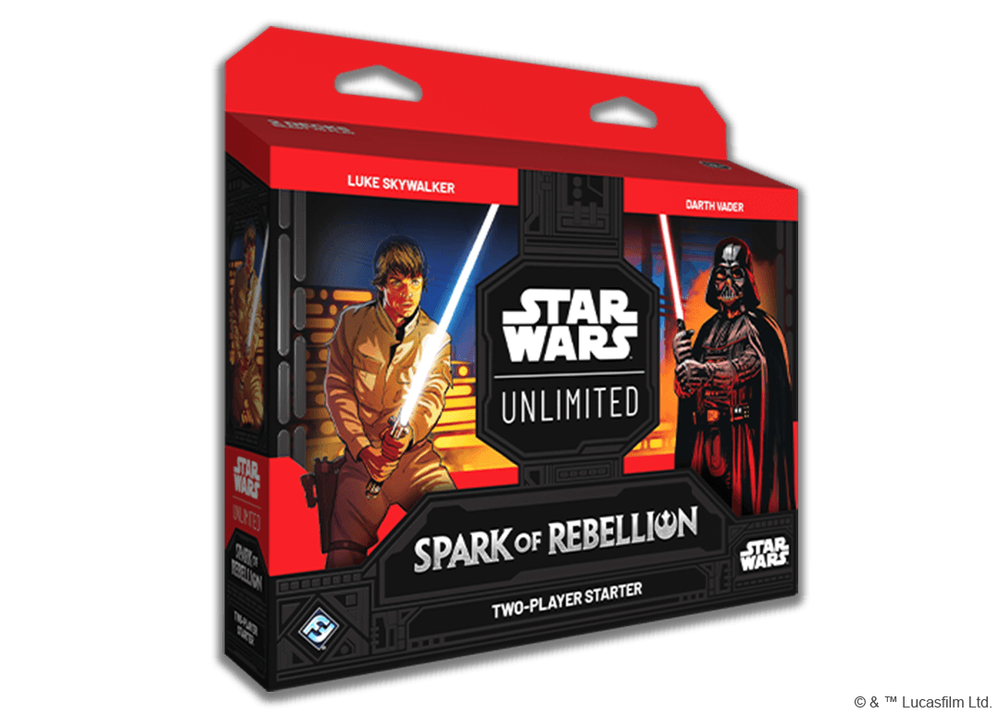
The two pre-built decks in this box provide everything you need to get started with your Star Wars: Unlimited collection. Each deck has been carefully put together to help you learn the game.
Each deck contains several cards that feature different keywords and mechanisms, but are simple enough for anyone to start playing with a beginner’s deck.
The box also includes quick start rules to help you get started with the game, all the markers and tokens you’ll use during the game, and even a pair of folded deck boxes to store the starter decks (or your own decks that you build in the future).
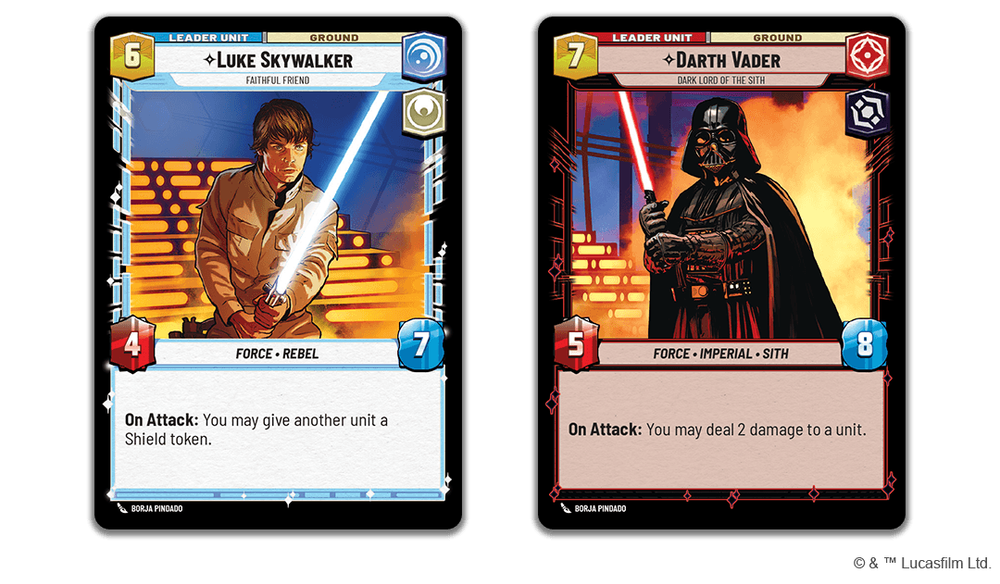
When you open the box, you have the choice between two different pre-built decks: One is a Luke Skywalker deck(The Spark of a Rebellion, 5) with the Vigilance, Sophistication and Heroism aspects.
The other is a Darth Vader deck(The Spark of a Rebellion, 10) with the aspects Aggression, Command and Infamy (you can read more about the aspects in this article).
The decks themselves are a mixture of cards that can be purchased in booster packs and unique cards that are only available in these starter decks.
For example, you can find General Dodonna(The Spark of Rebellion, 242) and General Veers(The Spark of Rebellion, 230) in The Spark of Rebellion booster packs, but Leia Organa(The Spark of Rebellion, 189) and Grand Moff Tarkin(The Spark of Rebellion, 84) can only be obtained from this box.
If you want to know what other cards can be found in these starting decks, just read on! Each of the cards shown in this article can be found in one of these two starter decks.
Note: The following is a step-by-step preview of the setup and gameplay of Star Wars: Unlimited. If you want to read the official quick start rules, click on this link.
Let’s go
To play a game of Star Wars: Unlimited, you and your opponent each place your base in the center of the table. Then each of you places your leader card with the horizontal side (not the side with the unit) facing up under your base.
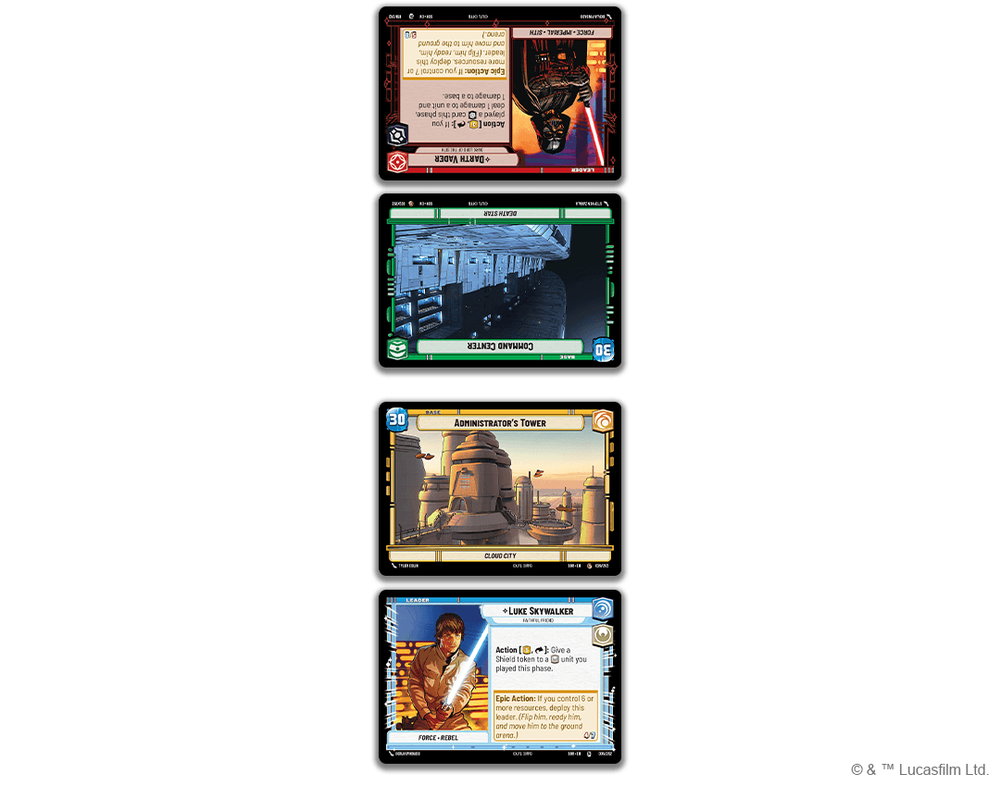
Next, you randomly determine which player starts the game with the initiative and give that player the initiative tile. Both players then shuffle their decks and draw 6 cards.
Everyone may take a “mulligan” once, i.e. you shuffle your entire hand back into your deck before drawing a new hand of 6 cards. Be careful, because you have to keep the new hand at all costs! Each player decides for himself whether he wants to take a mulligan or not.
Each player then chooses 2 cards from their hand and places them face down in front of them. They are referred to as “resources”. Resources are used to pay for cards that are played during the course of the game.
They can then no longer be used for their own abilities. We’ll go into more detail in a moment.
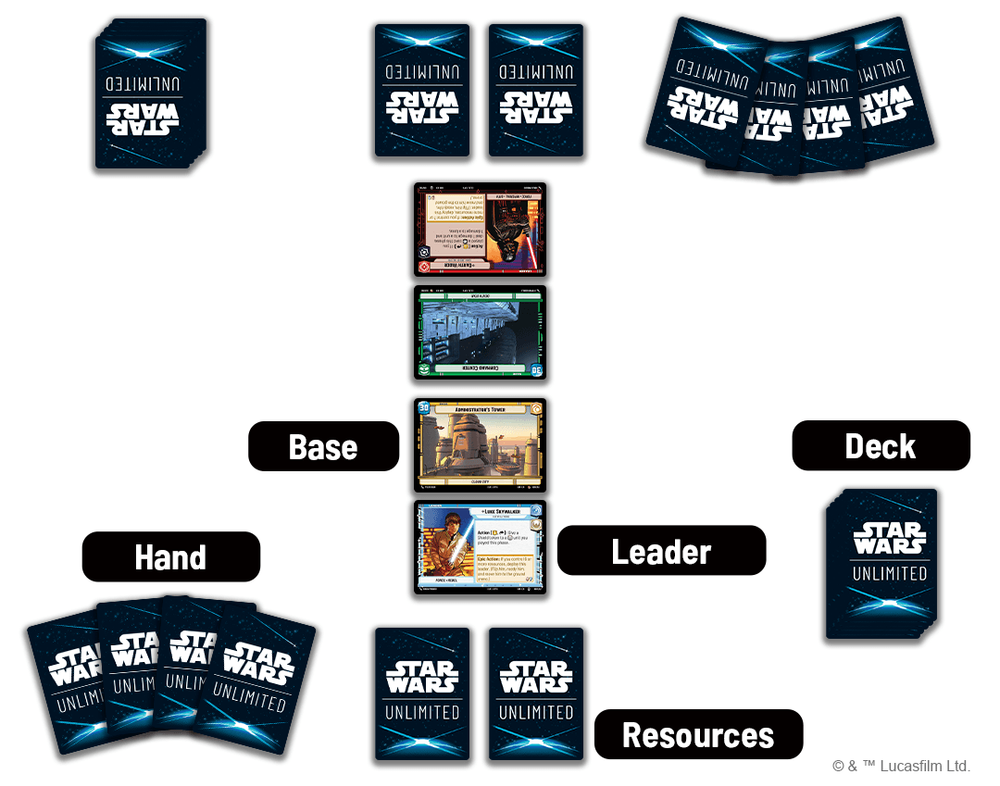
And that’s it already! As soon as both players are ready, the game begins with the first action phase.
Perform actions
The biggest part of a game Star Wars: Unlimited takes place in the action phase . In this phase, the players take turns and each perform a single action.
The player with the initiative tile performs the first action, then his opponent acts and so on until both players have passed.
The actions available to each player are: play a card, attack with a unit, use an action ability, take the initiative and pass.
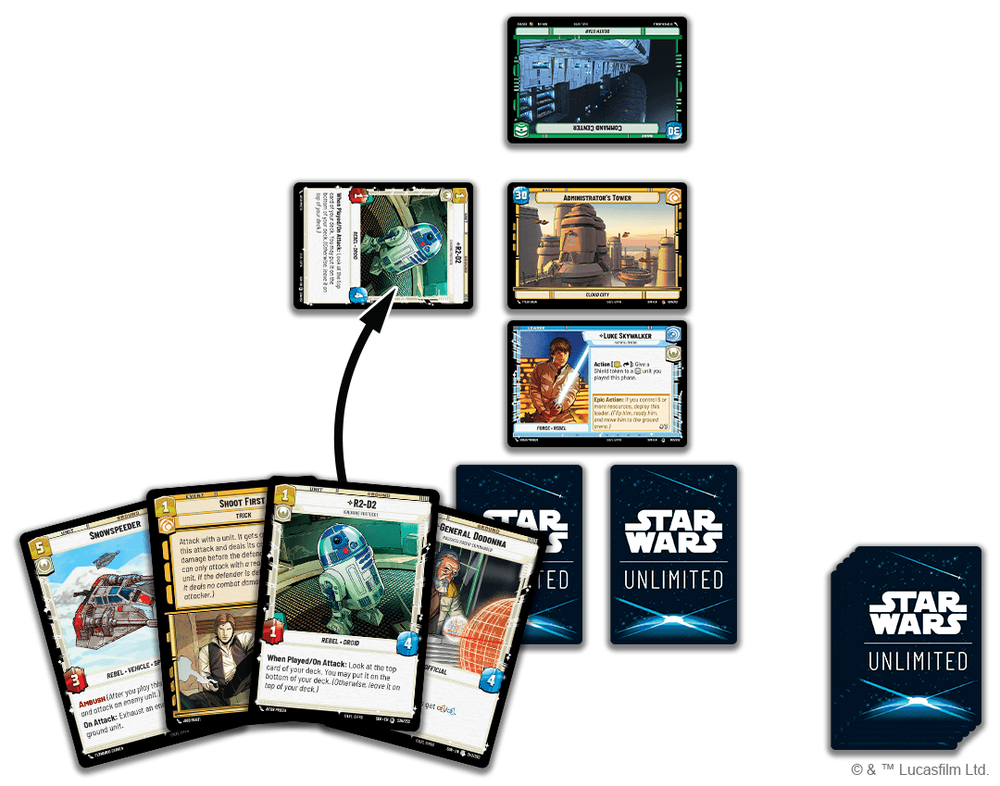
The first way to play a card is to “exhaust” (turn to the side) a number of resources equal to the cost of a card in your hand and then play that card.
As soon as a resource is exhausted, it can no longer be used until it is “ready to play” again (it has been rebuilt). The cost of a card is indicated by the number in the top left-hand corner.
For example, R2-D2(The Spark ofa Rebellion, 236) costs 1 resource to play, while I Am Your Father(The Spark of a Rebellion, 233) costs 3 resources.
When you play a unit , it enters the game exhausted. Ground units are played into the ground combat area, while space units are played into the space combat area.
The battle areas are to the left and right of your base, and which arena is which is determined by the first unit played; for example, if the first unit played is an Alliance X-Wing (The spark of a rebellion, 237), then the combat area into which it is played becomes the space combat area for that game.
Remember that units can only attack other units that are in the same combat area, so a good mix of ground and space units is crucial for success!
As soon as you play a unit, you immediately trade off all“If played” abilities it has. For example, the Viper Probe Droid (The Spark of a Rebellion, 228) lets you look at your opponent’s hand, while the Imperial Interceptor(The Spark of a Rebellion, 132) lets you deal 3 damage to a space unit.
When you play an upgrade , you must “attach” it to a unit by placing it under that unit. Upgrades often increase a unit’s strength and hit points (the red and blue numbers on the unit card) and can have additional effects depending on which upgrade it is and which unit it is attached to.
For example, Luke’s Lightsaber(The Spark of a Rebellion, 53) gives +3 Strength and +1 HP (or “+3/+1” for short) to any unit it is attached to; however, if you attach it to Luke Skywalker, it also gains an When Played effect that fully heals Luke and gives him a Shield granted(The spark of a rebellion, T02).
Likewise, any unit that is not a vehicle can use Vader’s Lightsaber(The Spark of a Rebellion, 136), but only Darth Vader himself can use his ability to deal 4 damage to a ground unit.
The third type of card you can play is an event. These cards have an effect that is resolved immediately as soon as the event is played. The card is then discarded. Events have all kinds of effects.
Some are defensive, such as Asteroid Sanctuary(The Spark of a Rebellion, 218), which can deplete an enemy and grant a shield to an ally.
Other events are offensive, such as Maximum Firepower(The Spark of a Rebellion, 234) and its ability to deal a large amount of damage to a single unit.
While most of the cards in these starter decks are units, the few events that are included in them can provide some additional strategic options to tip the game in your favor.
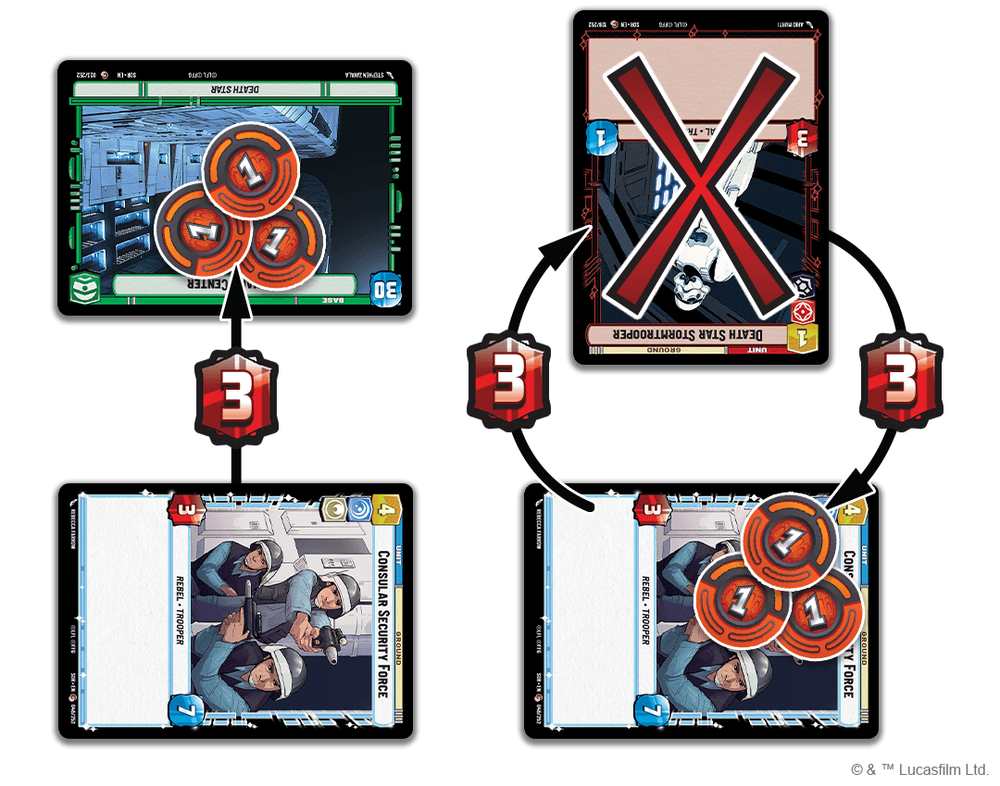
As soon as you have some units in play, you have access to further actions in your turn. To attack with a unit, you exhaust a ready unit that you control and select something you want to attack.
You can either attack an enemy unit in the same combat area or your opponent’s base. When you attack the base, you simply inflict damage equal to the strength of the attacking unit (the red number on its card). The aim of the game is to be the first to destroy the opponent’s base.
Deal enough damage to the enemy base and you win!
However, it often happens that your opponent has a unit that you cannot simply ignore. When you attack an enemy unit, both your unit and the defender deal damage equal to their respective strengths at the same time.
So if an Alliance X-Wing attacks a TIE/ln Fighter(The Spark of a Rebellion, 225), both ships deal 2 damage to each other simultaneously. The X-Wing has 3 HP (the blue number on its card), so it would still have 1 HP after taking 2 damage and would therefore still be in the game; the TIE fighter, however, has only 1 HP and would therefore be defeated after the ships have dealt damage to each other.
This is how combat works in its simplest form, but of course there are many cards that have attack-related abilities.
Normally a unit cannot attack on the same turn it enters play (as it enters play exhausted), but if a unit has the Ambush ability, such as a Snowspeeder(The Spark of Rebellion, 244), then it can attack an enemy unit as soon as it arrives.
The Snow Glider demonstrates another common unit trait: an attack ability. These abilities are triggered before damage is dealt during an attack and provide some additional effects when going on the offensive.
Of course, there are also units with defensive capabilities. Units like Admiral Motti(The Spark of aRebellion, 226) and Obi-Wan Kenobi (The Spark of a Rebellion, 49) have the If Defeated ability, which gives the player controlling them a kind of advantage when they are eliminated.
Obi-Wan and other units such as Cell Block Guard(The Spark of a Rebellion, 229) also have access to the Guard Post ability, which effectively prevents enemy units from attacking the base or allied units that do not also have guard posts.
There are also many other combat-related skills. Some units, like Han Solo (Spark of a Rebellion, 198), can deal damage first during an exchange, while others, like the AT-ST(Spark of a Rebellion, 232), can deal excess attack damage directly to the enemy base.
Some cards like Snowtrooper Lieutenant(The Spark ofaRebellion, 227) and Shoot First(The Spark of a Rebellion, 217) allow you to attack with a unit and gain an additional advantage. Don’t forget: A unit is always exhausted when it attacks, even if another card has enabled it to do so!
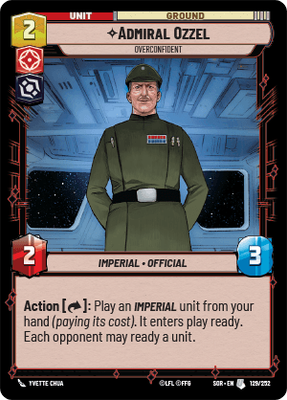
Another action you can perform on your turn is to use an action ability. If a card you control has an action ability, you may discard that ability (and pay any necessary costs).
For example, Admiral Ozzel(The Spark of a Rebellion, 129) has an action ability that allows you to play an Imperial unit from your hand and have it enter play ready instead of exhausted when you exhaust the Admiral (indicated by the small arrow after Action).
This ability also allows your opponent to get a unit ready to play, so be careful not to get cocky!
Leader cards are a special case. Most leaders not only have a normal action abilitythat can be used every round, but also a so-called epic action.
These work like normal action abilities, with the difference that each Epic Action can only be performed once per game. Each leader has an Epic Action that allows you to use him as a unit, provided you control enough resources.
This is always a big moment in the game, as your leader comes into play ready to play and is usually stronger than a normal unit.
However, if your leader is defeated, he turns back to the horizontal side, and since you have already used his Epic Action, you can no longer use him in this game!
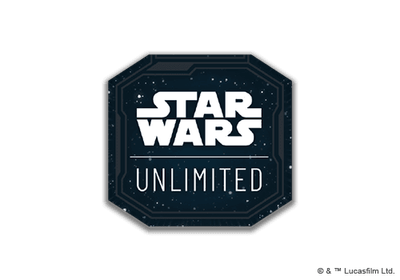
The last two actions, take initiative and pass, both mean that you basically “do nothing” during your turn. If you decide to pass, you do nothing in your turn and that’s it.
It is your opponent’s turn and then you can decide whether you want to pass again or perform another action.
If you take the initiative, you claim the initiative tile (even if you already have it) and guarantee that you will be the first to act in the next round.
However, as soon as you take the initiative, you have automatically passed for all subsequent actions in this action phase. Only one player can take the initiative in each round.
So if you take the initiative before your opponent, you can gain an advantage in the next round, but if you do this too early, your opponent could perform several actions in a row that could potentially turn the game in his favor!
As soon as both players have passed (either by taking the initiative or by simply passing), the action phase ends immediately and the game enters the collection phase.
Rest, freshen up and regroup
The collection phase consists of 3 steps: drawing cards, placing resources and preparing cards for play. Both players carry out these steps in the specified order.
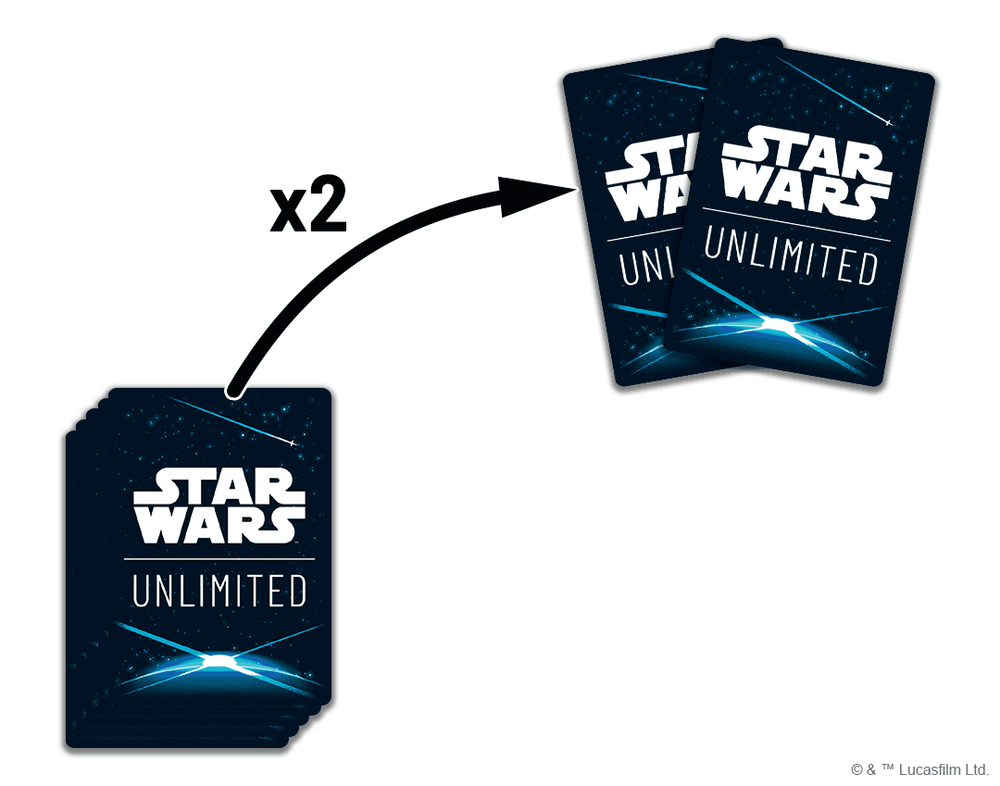
The first step is to draw 2 cards from the top of your deck. Nice and simple, right? This is the most common way to get more cards into your hand, but there are also a whole range of units and events that can earn you extra cards.
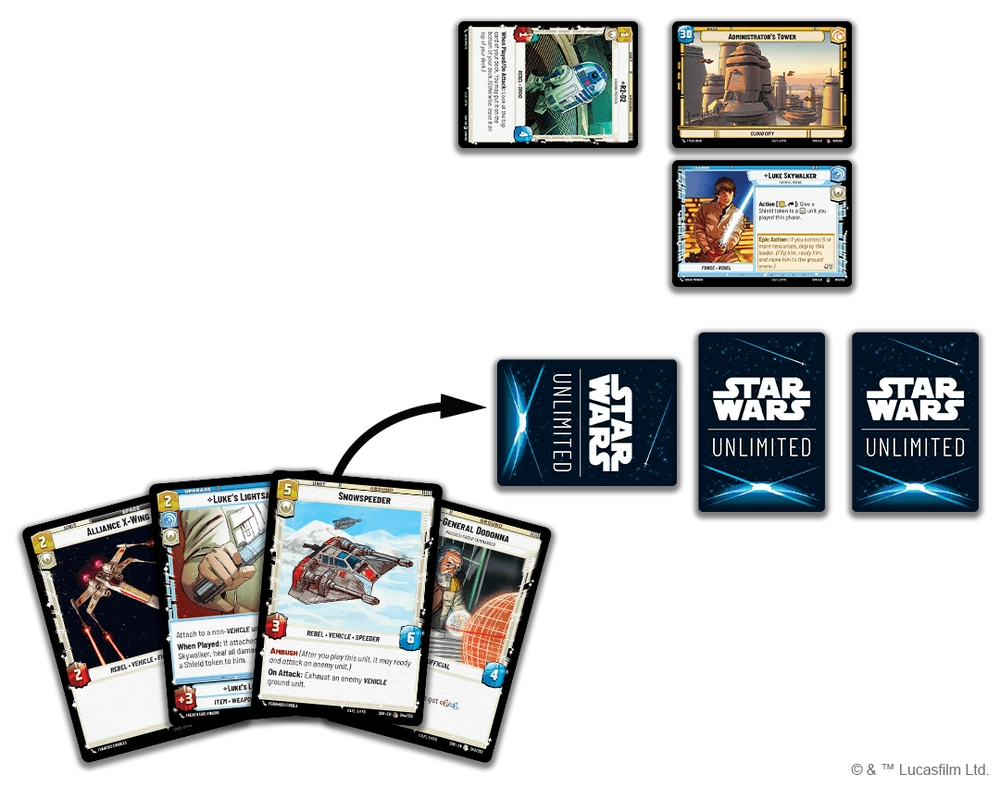
In the second step, you can choose 1 card from your hand and bring it into play face down as a resource.
This step is referred to as “creating a resource” and is optional. However, it is strongly recommended to place a resource every round until you have at least enough resources to use the leader’s Epic Action.
Normally, this step is the only way to increase the number of your resources.
However, certain cards – such as Resupply(The Spark of a Rebellion, 126) and Superlaser Technician(The Spark of a Rebellion, 83) – have abilities that increase your resources during the action phase.
This can affect the strategy of your deck, including how many high-cost cards you include in your deck – so always keep that in mind!
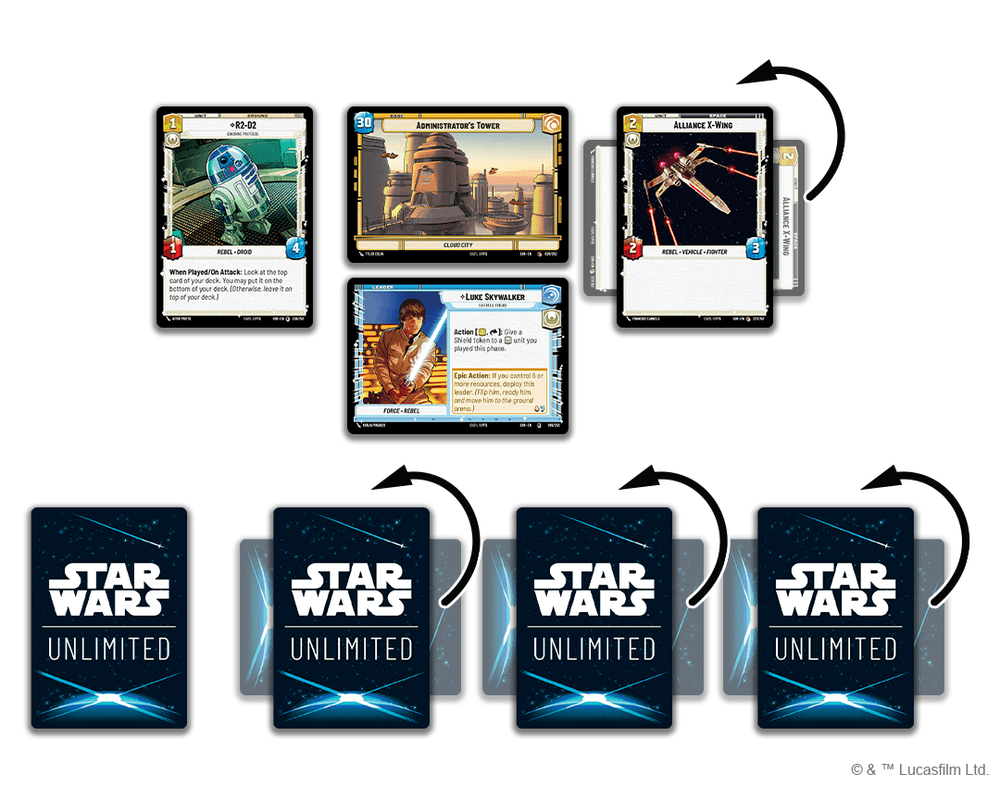
In the final step of the collection phase, you and your opponent make all your exhausted cards ready for play again, including units, resources and leaders. As soon as you have both done this, the game returns to the action phase. The player who currently has the initiative performs the first action and the cycle repeats.
And that’s it already! How to play a game Star Wars: Unlimited. The basic gameplay is simple and straightforward, but the different strategies and combinations available to you are… well, unlimited!
One more thing …
If you’re learning to play with starter decks, you’ll need matching sleeves for your cards, and our partner Gamegenic has them for you! You can look forward to these stylish Luke and Vader art sleeves together with Star Wars: Unlimited will be on shelves worldwide in 2024.
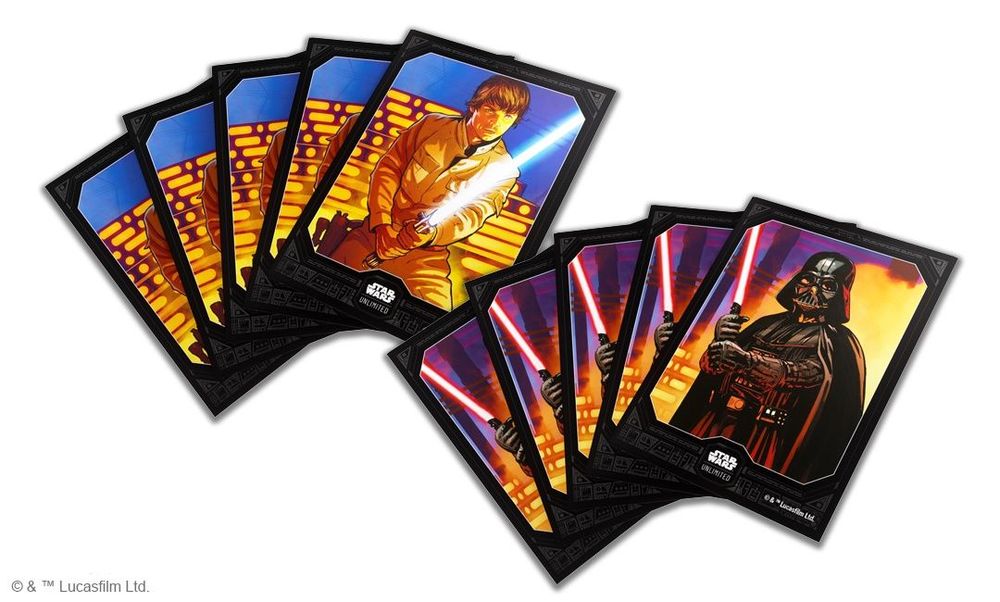
Art sleeves
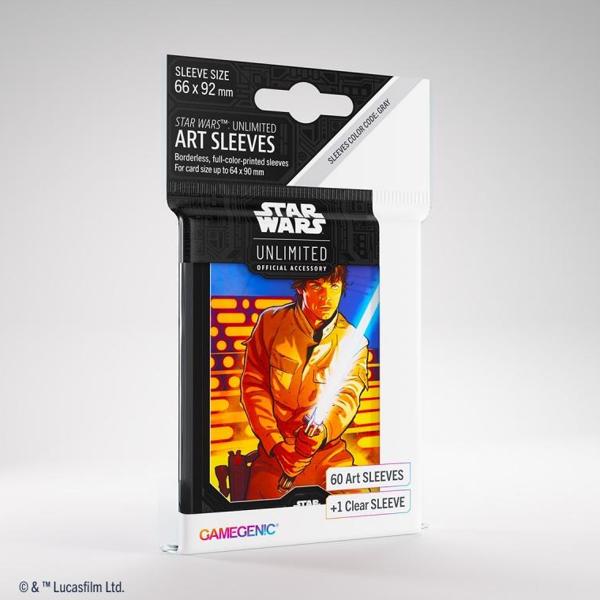
Find out exciting news and more about our products every week at varia.org/blog !


